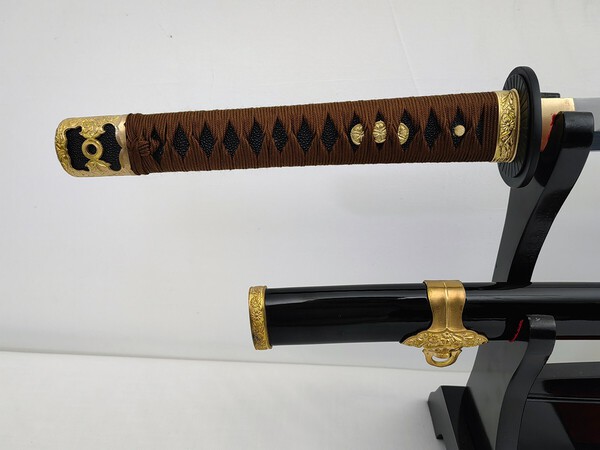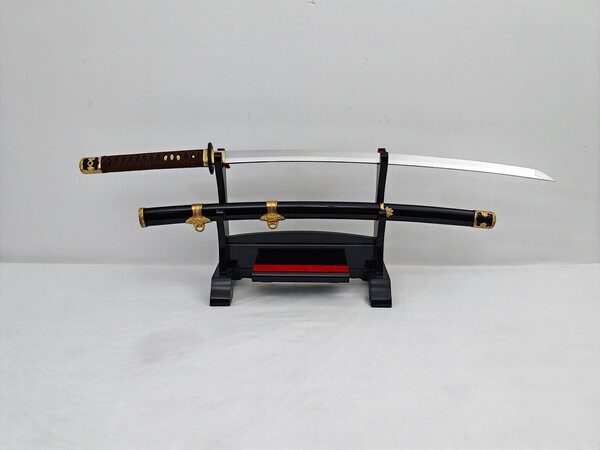
Lordd_Humungous
Members-
Posts
14 -
Joined
-
Last visited
Profile Information
-
Gender
Not Telling
-
Location:
Oregon
Profile Fields
-
Name
Jackson
Recent Profile Visitors
The recent visitors block is disabled and is not being shown to other users.
Lordd_Humungous's Achievements
-
Lordd_Humungous started following Where can I get a sword refitted with shin gunto parts? , Type 95 Repainting Questions , Your "Never Say Never, or Always" Sword and 1 other
-
Don't worry, I'm not repainting an antique, just a repro https://www.kultofathena.com/product/Japanese-nco-shin-gunto-sword/ If anyone knows what colors/shades are most accurate to an original Type 95, or anything about the painting process on aluminum, I'd like some advice.
-
Your "Never Say Never, or Always" Sword
Lordd_Humungous replied to Lordd_Humungous's topic in Military Swords of Japan
Here are a couple more examples of swords that I never thought I'd see: Beautifully decorated Type 3s -
One of my favorite phrases I've heard in this community is "never say never, or always" in reference to the massive world of unique gunto. So my question is, what are some of the most unique customizations, modifications and/or features you've seen on a gunto? I'll post some of mine, but this is the ultimate example: I wrote a short story called "Gunto Naoshi" in which a gunto is referenced that belongs to an officer descending from the Hojo clan, and I found almost the exact sword I described (as far as mountings go) on Ebay the other day. Here's the paragraph where the sword is described for reference: "A captured deserter, naked save for his underwear and a blindfold, was led from a tent by a rope around his neck and brought to the top of that very same hill beside the officer’s quarters. He was made to kneel with a shove, the rope was untied and removed to save it from being cut, and Officer Hojo drew his especially long, deeply curved ancestral blade from its red iron scabbard. Hojo’s gunto was a unique sword passed down through his family since before the end of the bakufu in the middle of the seventeenth century, and early in the war he had paid more yen than one of his soldiers made in a year to have it mounted in a beautifully crafted ornate handle with his clan crest displayed alongside the imperial chrysanthemum in a gold charm laid between the white samegawa and the brown silk. The decorated iron scabbard was custom made to fit the blade, which was as long as a man’s leg and nearly as curved as a crescent moon. The sword took the deserter’s head off in a single blow with a meaty thwacking sound, and we soldiers all cheered while Officer Hojo smiled and bowed and poured a canteen of water over the blade to wash the blood off of it."
-
I'm travelling to Tokyo in a few months, and I'm curious about buying a blade there. My budget might be laughable to some, but I'd like to spend less than $1,000 USD if possible. I'm not particularly picky in terms of what I want to the point that if all else is off the table I'd get an iaito, bokken, or a koshirae set with a wooden insert in place of a blade. I've just been a backyard tatami cutter and collector of modern reproductions for long enough that the mission is essentially to get a piece where the pride of ownership simply comes from it being from Japan, and it will be appreciated from a display (with proper care if it's an antique of course). So basically, I want to get something closely linked to my sword hobby even if it ends up being gramps' old Gunto tsuba found at a flea market. Keep in mind that I don't speak the language so a detailed conversation with a seller there isn't really possible. 1. What legally counts as a sword there? If I can avoid the export process that would of course be ideal. For example, when does a knife become a tanto? Kiridashi are often in wooden handles/sheaths resembling shirasaya minus the mekugi, so does the assembly have anything to do with it? Or is it the forging process that makes something a sword? I know Gunto with machine-made blades are destroyed by law there and that anything which counts as a sword must be made using traditional methods in-country by a registered smith, but is it possible that some monosteel "tanto" get around the laws by moreso counting as "knives"? And I think I've heard that yari heads count as swords, but would something like a jitte/kabutowari dressed up in sword-like koshirae count as a sword? What about a kozuka? What would be the closest thing to a traditional metal Japanese weapon which could be purchased without the sword export process? 2. Where would I go to look/make a purchase? Would antique stores possibly carry things like old tired blades, fittings/koshirae, etc? If not, are there specific stores which sell koshirae, related "weapons" like jitte/kabutowari (if they don't count as swords), etc? Do knife stores which are geared less toward culinary and more toward martial arts purposes exist? I'm sure more questions will spawn from discussion, and thank you to anyone who's willing to give this white barbarian layman the time of day and answer his questions. Thanks, Jackson
-
I'll never stop being surprised by the kinds of guntos out there (until I buy that encyclopedia on them that gets recommended here). I mean, you have family heirloom katanas in some or most of their original koshirae, naginata naoshi wakizashi, tantos crammed into double hanger Kai Gunto mounts, it's all just crazy. I've been especially fascinated by late war guntos recently, since it seems like many of the factories just had to work with whatever parts or metals they had on hand, which led to all sorts of interesting hodge podge koshirae (like mixing type 3 and type 98 parts), makeshift fittings (my favorite being one that used what Ohmura calls an "oblong plate" as a menuki) and other features that aren't found on any early war swords (it really seems like for some of the late swords, they just found a local guy who had a random kabutogane and recasted it). I'm not sure if there's already a thread on this, so let me know if there is. If not, let's see those feats of resourcefulness!
-
I tried to have a replica of a Kai gunto made, but they used different parts. Now I'm trying to see if I can have some of those incorrect parts switched out for the shin gunto parts that are found on "Naval Landing Forces" guntos so the sword is at least accurate to some kind of real historical sword.
-
I have a sword that was made to look like a "kai gunto" that has some major inaccuracies which have only started to bother me recently. I contacted the Fred Lohman company because I know they make repro shin gunto fittings (so I could have it converted to an NLF style gunto) but when I reached out, I received an email back saying that the company has shut down for the foreseeable future. If anyone knows of another avenue to have the saya fittings and/or kabutogane switched out for shin gunto fittings, or if there's a saya maker who can at least make a new saya in the NLF style, let me know. I suppose a saya with a black leather cover could also simulate something you'd see from the Japanese Navy. If this thread is off-topic because it deals in repros, I apologize and ask where else could I post these questions? Thank you
-
If you were looking to restore a type 95 that's had its paint all or mostly worn off, how would you do it? I know that may be haram on here, but I'm genuinely curious so if anyone has ideas on other places to ask (such as communities based around painting aluminum models) let me know. There's a type 95 for $299 at a store near me (it may be a fake, but then that's even more reason to repaint) that's in that kind of condition and since I would put it in the same display as my reproductions I'd want to restore it for aesthetic reasons. I anticipate correct colors such as brownish copper for the fuchi and yellowish brass for the menuki may be the hardest part.
-
Copper or brass fittings?
Lordd_Humungous replied to Lordd_Humungous's topic in Military Swords of Japan
Well that explains the switch to iron fittings for the type 3 -
Copper or brass fittings?
Lordd_Humungous replied to Lordd_Humungous's topic in Military Swords of Japan
Is it usually copper plated? On ohmura and the threads in this forum it looks like most swords fittings have a reddish tint if not a dark brownish red finish. -
Which was used most commonly for type 98s, copper (with brass accents), brass, or brass with copper plating? Reading around, I've seen claims that all three were used to some degree but it looks like in terms of commonality it goes copper>copper-plated>brass
-
I have a sword that's missing the ring on the scabbards hanger. It's a replica, the maker said they just couldn't get the ring on then forgot to send it along with the sword. So I was wondering if there's any precedent for this, like if anyone has an idea on how to add a ring. The reproduction rings have a cut through them, but they don't seem easy to pry open then force "closed" again.


.thumb.png.4e783460985cbd08c417273440f5c074.png)



.png.884c14826cba71e74fbea3f744404fcf.png)


